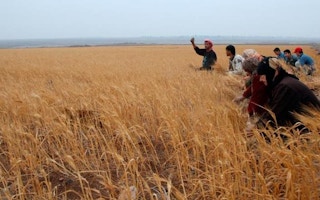Plant scientists are planning to conserve the wild relatives of important food crops in their natural habitats, but face a barrier because a significant proportion are found in conflict zones in the Middle East, including Syria and Iraq.
Scientists from the University of Birmingham have identified “hotspots” around the globe where crop wild relatives – species plant breeders use to develop new crop varieties that are more resistant to climate extremes, pests and diseases – could be protected on the ground. That would help secure future global food resources.
Globally these wild relatives are most concentrated in the region known are the “Fertile Crescent”, which arcs around the Arabian desert and includes Jordan, the Palestinian territories, Israel, Syria, Lebanon, Turkey, Iraq and Iran.
“
If we combine global population growth with the prospect of climate change decreasing crop yields by 2 per cent per decade, crop wild relatives may be one solution to this food security threat - but not if we don’t have access to them or the species are extinct
Nigel Maxted, lead investigator, University of Birmingham’s School of Biosciences
Conflict in some of these countries - with parts held by extremist Muslim groups - makes in-situ conservation very difficult in practice, Nigel Maxted, lead investigator from the University of Birmingham’s School of Biosciences in Britain, told Thomson Reuters Foundation.
“It won’t necessarily speed up extinction of the species, but the problem is access,” he said. “If Islamic State takes over an area, then we don’t have access to the (plant) material there.”
Syria is a case in point. Two of the most important sites in the world for wild relatives of crops - including wheat and sugar beet - are located in the war-torn country, according to Maxted.
The International Center for Agricultural Research in the Dry Areas (ICARDA) has been forced to duplicate a globally unique collection of crop genetic resources that were kept at its gene bank in Aleppo, in Syria, by shipping seeds to the Svalbard Global Seed Vault in Norway where they can be kept safe.
Government support needed
The Birmingham university team is joining with the UN Food and Agriculture Organisation (FAO) to plan and implement effective conservation of crop wild relatives for the first time in the countries where they are found around the world, as well as taking samples and placing them in gene banks as a back-up.
They plan to negotiate with governments in the Fertile Crescent to highlight the plight of the species, and to try to implement conservation in the hotspot areas. But Maxted said it won’t be possible in Syria for the time being.
Another challenge is that these wild relatives of crops are concentrated in developing countries, which often lack the skills and resources to protect them properly, Maxted said, stressing the need for new funding for such efforts.
They are increasingly important because the growing risks to crops from climate change means there is rising demand from plant breeders for resilient traits that are found in wild relatives.
For example, Saccharum arundinaceum, a relative of sugar cane, can survive very low temperatures, and Prunus ferganensis, a wild relative of peach, is tolerant to drought conditions. A wild relative of wheat, Aegilops tauschii, is resistant to Hessian fly, a pest of cereal crops.
But research at Birmingham shows that 12 per cent of crop wild relatives are threatened with extinction, and all are likely to be already suffering a loss of genetic diversity for reasons including habitat destruction and alteration, conflict, intensive agriculture and urbanisation.
Conserving them in the locations where they are naturally found is important because it means they can continue to adapt to changing climatic conditions, as well as threats from pests and diseases, Maxted said.
“If we combine global population growth with the prospect of climate change decreasing crop yields by 2 per cent per decade, crop wild relatives may be one solution to this food security threat - but not if we don’t have access to them or the species are extinct,” he said.










